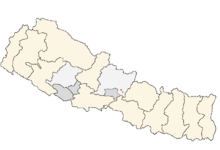Kusunda language
| Kusunda | |
|---|---|
| Ban Raja | |
| mihaq | |
| Native to | Nepal |
| Region | Gandaki Zone |
| Ethnicity | 160 (no date) |
|
Native speakers
|
3 (2017) |
| Language codes | |
| ISO 639-3 | |
| Glottolog | kusu1250 |

Ethnologue locations: (west) Dang and Pyuthan districts (dark grey) within Rapti Zone; (center) Tanahu District within Gandaki Zone
EndangeredLanguages.com location: red WALS location: purple (Gorkha District) |
|
Kusunda (Kusanda) is a language isolate spoken by a handful of people in western and central Nepal. It has only recently been described in any detail.
For decades the Kusunda language was thought to be on the verge of extinction, with little hope of ever knowing it well. The little material that could be gleaned from the memories of former speakers suggested that the language was an isolate, but without much evidence either way it was often classified along with its neighbors as Tibeto-Burman. However, in 2004 three Kusundas, Gyani Maya Sen, Prem Bahadur Shahi and Kamala Singh, were brought to Kathmandu for help with citizenship papers. There, members of Tribhuvan University discovered that one of them was a fluent speaker of the language. Several of her relatives were also discovered to be fluent. There are now known to be at least seven or eight fluent speakers of the language, the youngest in her thirties. However, the language is moribund, with no children learning it, as all Kusunda speakers have married outside their ethnicity.
Watters (2005) published a mid-sized grammatical description of the language, plus vocabulary, which shows that Kusunda is indeed a language isolate, not just genealogically but also lexically, grammatically, and phonologically distinct from its neighbors. It appears that Kusunda is a remnant of the languages spoken in northern India before the influx of Tibeto-Burman- and Indo-Iranian-speaking peoples, however it is not classified as a Munda or a Dravidian language. See also Burushaski, Nihali and (potentially) the substrate of the Vedda language for other Indian languages which don't fall into the main categories of Indo-European, Dravidian, Tibeto-Burman and Australasian.
Phonetically, Kusunda has six vowels in two harmonic groups, which are arguably three vowels phonemically: a word will normally have vowels from the upper (pink) or lower (green) set, but not both simultaneously. There are very few words that consistently have upper or lower vowels; most words may be pronounced either way, though those with uvular consonants require the lower set (as in many languages). There are a few words with no uvular consonants that still bar such dual pronunciations, though these generally only feature the distinction in careful enunciation.
...
Wikipedia
